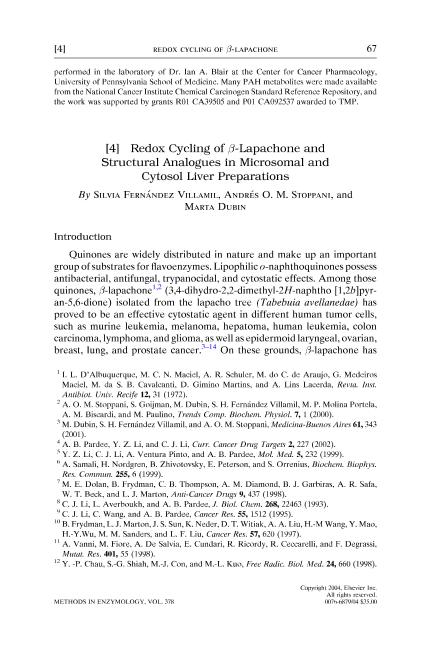Mostrar el registro sencillo del ítem
dc.contributor.author
Fernandez Villamil, Silvia Hebe

dc.contributor.author
Stoppani, Andrés O. M.
dc.contributor.author
Dubin, Marta

dc.date.available
2019-07-19T13:48:23Z
dc.date.issued
2004-12
dc.identifier.citation
Fernandez Villamil, Silvia Hebe; Stoppani, Andrés O. M.; Dubin, Marta; Redox Cycling of β-Lapachone and Structural Analogues in Microsomal and Cytosol Liver Preparations; Elsevier Academic Press Inc; Methods In Enzymology.; 378; 12-2004; 67-87
dc.identifier.issn
0076-6879
dc.identifier.uri
http://hdl.handle.net/11336/79881
dc.description.abstract
The lipophilic o-naphthoquinones beta-lapachone and structural analogous quinones (CG quinones) are proposed as cytostatic, trypanocidal and antiviral agents. With rat liver microsomal NAD(P)H cytochrome P450 reductase or cytosol flavoenzyme DTD, these quinones constitute redox systems that in the presence of oxygen generate ROS. o-Naphthoquinones redox cycling, catalyzed by the NADPH cytochrome P450 reductase, generate in microsomal liver preparations: (a) semiquinone free radicals, (b) ROS and (c) inhibition of cytochrome P450-dependent reactions, exerting cytotoxic effects. Hydroquinones, are the immediate products of quinones reduction by the DTD-dependent systems. Three types of hydroquinones formed by that reaction have been proposed by Cadenas: (a) redox stable hydroquinones; (b) redox labile hydroquinones that subsequently reoxidize, with formation of semiquinone and ROS and (c) redox-labile semiquinones that immediately rearrange to potent electrophils undergoing biological alkylating reactions. Our observations with beta-lapachone and related o-naphthoquinones indicate that the corresponding hydroquinones must be included in the second group in agreement with (a) the semiquinone spectrum, demonstrated by ESR spectroscopy; (b) semiquinone (or quinone) production demonstrated by optical spectroscopy and; (c) the effect of dicoumarol on the quinone redox-cycling and oxygen consumption by the NADPH/o-naphthoquinone/DTD system. These reactions associated to DTD activity seem to rule out the contention proposing DTD as an antioxidant enzyme protecting against quinone toxicity.
dc.format
application/pdf
dc.language.iso
eng
dc.publisher
Elsevier Academic Press Inc

dc.rights
info:eu-repo/semantics/openAccess
dc.rights.uri
https://creativecommons.org/licenses/by-nc-sa/2.5/ar/
dc.subject
Naphthoquinones
dc.subject
Redox Cycle
dc.subject.classification
Bioquímica y Biología Molecular

dc.subject.classification
Ciencias Biológicas

dc.subject.classification
CIENCIAS NATURALES Y EXACTAS

dc.title
Redox Cycling of β-Lapachone and Structural Analogues in Microsomal and Cytosol Liver Preparations
dc.type
info:eu-repo/semantics/article
dc.type
info:ar-repo/semantics/artículo
dc.type
info:eu-repo/semantics/publishedVersion
dc.date.updated
2019-07-16T14:14:43Z
dc.journal.volume
378
dc.journal.pagination
67-87
dc.journal.pais
Estados Unidos

dc.journal.ciudad
Burlington
dc.description.fil
Fil: Fernandez Villamil, Silvia Hebe. Universidad de Buenos Aires; Argentina. Consejo Nacional de Investigaciones Científicas y Técnicas. Instituto de Investigaciones en Ingeniería Genética y Biología Molecular "Dr. Héctor N. Torres"; Argentina
dc.description.fil
Fil: Stoppani, Andrés O. M.. Universidad de Buenos Aires; Argentina
dc.description.fil
Fil: Dubin, Marta. Universidad de Buenos Aires; Argentina. Consejo Nacional de Investigaciones Científicas y Técnicas. Instituto de Investigaciones en Ingeniería Genética y Biología Molecular "Dr. Héctor N. Torres"; Argentina
dc.journal.title
Methods In Enzymology.

dc.relation.alternativeid
info:eu-repo/semantics/altIdentifier/doi/http://dx.doi.org/10.1016/S0076-6879(04)78004-0
dc.relation.alternativeid
info:eu-repo/semantics/altIdentifier/url/https://www.sciencedirect.com/science/article/pii/S0076687904780040
Archivos asociados
